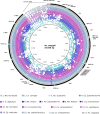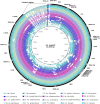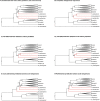Culicidae evolutionary history focusing on the Culicinae subfamily based on mitochondrial phylogenomics
- PMID: 33139764
- PMCID: PMC7606482
- DOI: 10.1038/s41598-020-74883-3
Culicidae evolutionary history focusing on the Culicinae subfamily based on mitochondrial phylogenomics
Abstract
Mosquitoes are insects of medical importance due their role as vectors of different pathogens to humans. There is a lack of information about the evolutionary history and phylogenetic positioning of the majority of mosquito species. Here we characterized the mitogenomes of mosquito species through low-coverage whole genome sequencing and data mining. A total of 37 draft mitogenomes of different species were assembled from which 16 are newly-sequenced species. We datamined additional 49 mosquito mitogenomes, and together with our 37 mitogenomes, we reconstructed the evolutionary history of 86 species including representatives from 15 genera and 7 tribes. Our results showed that most of the species clustered in clades with other members of their own genus with exception of Aedes genus which was paraphyletic. We confirmed the monophyletic status of the Mansoniini tribe including both Coquillettidia and Mansonia genus. The Aedeomyiini and Uranotaeniini were consistently recovered as basal to other tribes in the subfamily Culicinae, although the exact relationships among these tribes differed between analyses. These results demonstrate that low-coverage sequencing is effective to recover mitogenomes, establish phylogenetic knowledge and hence generate basic fundamental information that will help in the understanding of the role of these species as pathogen vectors.
Conflict of interest statement
The authors declare no competing interests.
Figures





Similar articles
-
Mitogenome-based phylogeny of mosquitoes (Diptera: Culicidae).Insect Sci. 2024 Apr;31(2):599-612. doi: 10.1111/1744-7917.13251. Epub 2023 Jul 25. Insect Sci. 2024. PMID: 37489338
-
First record of translocation in Culicidae (Diptera) mitogenomes: evidence from the tribe Sabethini.BMC Genomics. 2019 Sep 27;20(1):721. doi: 10.1186/s12864-019-6069-3. BMC Genomics. 2019. PMID: 31561749 Free PMC article.
-
DNA barcoding of morphologically characterized mosquitoes belonging to the subfamily Culicinae from Sri Lanka.Parasit Vectors. 2018 Apr 25;11(1):266. doi: 10.1186/s13071-018-2810-z. Parasit Vectors. 2018. PMID: 29695263 Free PMC article.
-
Mosquito genomics: progress and challenges.Annu Rev Entomol. 2012;57:143-66. doi: 10.1146/annurev-ento-120710-100651. Epub 2011 Sep 19. Annu Rev Entomol. 2012. PMID: 21942845 Review.
-
Of Genes and Genomes: Mosquito Evolution and Diversity.Trends Parasitol. 2019 Jan;35(1):32-51. doi: 10.1016/j.pt.2018.10.003. Epub 2018 Nov 1. Trends Parasitol. 2019. PMID: 30391118 Review.
Cited by
-
Shallow Whole-Genome Sequencing of Aedes japonicus and Aedes koreicus from Italy and an Updated Picture of Their Evolution Based on Mitogenomics and Barcoding.Insects. 2023 Nov 23;14(12):904. doi: 10.3390/insects14120904. Insects. 2023. PMID: 38132578 Free PMC article.
-
Evaluation of Aedes aegypti control intervention with pyriproxyfen by lcWGS in Manacapuru, Amazonas, Brazil.PLoS Negl Trop Dis. 2024 Oct 3;18(10):e0012547. doi: 10.1371/journal.pntd.0012547. eCollection 2024 Oct. PLoS Negl Trop Dis. 2024. PMID: 39361714 Free PMC article.
-
Speciation patterns of Aedes mosquitoes in the Scutellaris Group: a mitochondrial perspective.Sci Rep. 2024 May 13;14(1):10930. doi: 10.1038/s41598-024-61573-7. Sci Rep. 2024. PMID: 38740928 Free PMC article.
-
In vitro larvicidal activity of selected azabenzimidazole and diarylquinoline derivatives against Anopheles gambiae and in silico mechanistic analysis.Mol Divers. 2025 Apr 10. doi: 10.1007/s11030-025-11189-4. Online ahead of print. Mol Divers. 2025. PMID: 40210815
-
Chronological Incongruences between Mitochondrial and Nuclear Phylogenies of Aedes Mosquitoes.Life (Basel). 2021 Feb 25;11(3):181. doi: 10.3390/life11030181. Life (Basel). 2021. PMID: 33669100 Free PMC article.
References
-
- Molaei G, Andreadis TG, Armstrong PM, Diuk-Wasser M. Host-feeding patterns of potential mosquito vectors in Connecticut, USA: molecular analysis of bloodmeals from 23 species of Aedes, Anopheles, Culex, Coquillettidia, Psorophora, and Uranotaenia. J. Med. Entomol. 2008;45:1143–1151. doi: 10.1093/jmedent/45.6.1143. - DOI - PubMed
-
- Tiawsirisup S, Nithiuthai S. Vector competence of Aedes aegypti (L.) and Culex quinquefasciatus (Say) for Dirofilaria immitis (Leidy) Southeast Asian J. Trop. Med. Public Health. 2006;37(Suppl 3):110–114. - PubMed
Publication types
MeSH terms
Associated data
LinkOut - more resources
Full Text Sources
Medical

